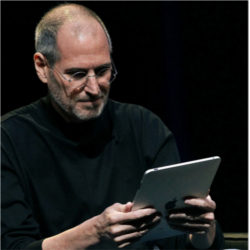
It is ironic that Steve Jobs, the man who focused on building consumer-friendly devices such as the iPod, iPhone, and iPad, is now radically reshaping the business world. Not even a year after Apple’s founder passed away, the remarkable changes unleashed by his ideas and inventions are fully taking shape. In fact, they are ushering in an entirely new approach to information technology.
It is called IT consumerization and it is now on virtually every company’s radar. For years, organizations and their IT departments dictated what hardware employees would use and how they would use it. That, in turn, controlled what software employees used and how they went about their work. Apple was not invited to this party. It was a consumer-oriented computing platform that had absolutely no place in a corporate world ruled by Windows and hulking enterprise applications.
Then, in 2008, Steve Jobs introduced the iPhone. Just like the Mac, it was a consumer device that seemed to have no place in the then BlackBerry-dominated enterprise. But a funny thing happened. Hip employees—followed by influential executives—began carrying their new iPhones into meetings … and the boardroom. Pretty soon everyone wanted an iPhone.
Next, Jobs introduced the iPad in 2010. An optimum form factor combined with the resounding superiority of the iOS platform further transformed the enterprise. Many workers were no longer interested in lugging around a 20th century laptop. They wanted the sleek and incredibly powerful 21st century iPad. Once software vendors such as Evernote, Dropbox, QuickOffice, and Skype joined the party, the verdict was in. You could suddenly do almost everything you could do on a laptop on an iPad … and more.
Apple’s sales literally soared and iPad and iPhone adoption went off any known scale. During the first quarter of 2012, Apple sold an incredible 11.8 million iPads worldwide, up more than 150% from the year-ago period. It also sold more than 35.1 million iPhones, an 85% increase from the previous year’s quarter. Simply put, the line between personal and business computing is blurring.
Forrester Research analyst Ted Schadler describes Jobs as “the accidental architect of consumerization.” He notes that during the dark days of the 1990s and early 2000s, "nobody could have seen that Steve Jobs and Apple would overtake the enterprise. But it happened.”
Eyes on Business
There is a name for this phenomenon: Bring Your Own Device (BYOD). And, make no mistake, this IT consumerization trend is radically reshaping the modern enterprise in ways that could not have been imagined even three years ago. Today, employees use their chosen devices, often iPhones and iPads, to load their own apps, tap into social media services, and mix work and personal activities with growing frequency. They are able to do work anywhere, anytime, and sync data over iCloud, yet another Steve Jobs creation.
The proverbial genie is out of the bottle. Gary Curtis, chief technology strategist for Accenture, says that younger workers are increasingly thumbing their noses at IT policies, using non-standard applications and “improving” work processes whenever and wherever they deem it necessary. According to Accenture, a staggering 61% of millennial workers use social networking services that are not supported by their IT department. In addition, 43% tap into non-supported IM, 31% rely on rogue open source technologies, and 26% use their own online collaboration tools.
Of course, this evolving BYOD frontier presents new risks. It is changing the way IT departments build out infrastructure and enable security features, as IT consumerization also creates new cracks that hackers and cybercriminals can exploit.
Yet, business and IT leaders are beginning to comprehend that, even if they could ban these devices, they would not want to do so. For one thing, mobility and the cloud beget exponential leaps in productivity. For another, it is next-to-impossible to attract and retain talent—particularly critical skill employees—with a hierarchical top-down approach to computing. Accenture found that 87% of U.S Millennials—typically those born between about 1980 and 1995s—decide where they will work based on their ability to use state-of-the-art technology. Finally, as employees carry their own devices, businesses find that they save considerable sums on phones, cellular plans, and other gear.
Organizations are recognizing this new normal. For example, at IBM, which has about 433,000 employees worldwide, upward of 100,000 employees connect their personal devices to the corporate network. Another 100,000 will gain access this year. In addition, IBM has built an internal app store, WhirlWind, which went live in in September 2010. It lets workers download approved apps, including business apps built in house. At present, workers tally more than 4,000 downloads per month. Other companies, including GE, Unisys, and Medtronic, have followed suite and built their own app stores.
It would be an overstatement to say that Steve Jobs singlehandedly spurred IT consumerization and the BYOD revolution. Social media and mobility in general have also played significant roles. It would also be presumptuous to assume that Apple has completely taken over the enterprise. It steadfastly refuses to offer a product roadmap the way Hewlett-Packard or Dell does. Also, it is unlikely that any major company will make a wholesale switch from Windows to Macs anytime soon.
But Jobs’s fingerprints are everywhere—and there’s no question that powerful and pervasive consumer technology will continue to alter the business landscape. By inventing devices that are incredibly simple to use and designing a framework for mobility that is too tempting to resist, Jobs ultimately transformed business and IT from the outside in. As Schadler puts it, “The world of workforce technology will never be the same.”
Samuel Greengard is an author and journalist based in West Linn, OR.



Join the Discussion (0)
Become a Member or Sign In to Post a Comment